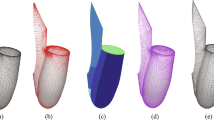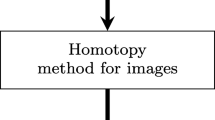Abstract
Traditional Verlet integration frameworks have been successful with their robustness and efficiency to simulate deformable bodies ranging from simple cloth to geometrically complex solids. However, the existing frameworks deform the models as a whole. We present a Verlet integration framework which provides local surface deformation on the selected area of the mesh without giving any global deformation impact to the whole model. The framework is specifically designed for facial surfaces of the cartoon characters in computer animation. Our framework provides an interactive selection of the deformation influence area by using geodesic distance computation based on heat kernel. Additionally, the framework exploits the geometric constraints for stretching, shearing and bending to handle the environmental interactions such as collision. The proposed framework is robust and easy to implement since it is based on highly accurate geodesic distance computation and solving the projected geometric constraints. We demonstrate the benefits of our framework with the results obtained from various facial models to present its potential in terms of practicability and effectiveness.
Access this chapter
Tax calculation will be finalised at checkout
Purchases are for personal use only
Similar content being viewed by others
References
Bender, J., Koschier, D., Charrier, P., Weber, D.: Position-based simulation of continuous materials. Comput. Graph. 44, 1–10 (2014)
Bender, J., Müller, M., Macklin, M.: Position-based simulation methods in computer graphics. In: EUROGRAPHICS 2015 Tutorials (2015)
Bender, J., Müller, M., Otaduy, M.A., Teschner, M.: Position-based methods for the simulation of solid objects in computer graphics. In: EUROGRAPHICS 2013 State of the Art Reports (2013)
Bergou, M., Mathur, S., Wardetzky, M., Grinspun, E.: Tracks: toward directable thin shells. ACM Trans. Graph. 26(3), 50:1–50:10 (2007)
Bridson, R., Marino, S., Fedkiw, R.: Simulation of clothing with folds and wrinkles. In: Proceedings of the 2003 ACM SIGGRAPH/Eurographics Symposium on Computer Animation (2003)
Crane, K., Weischedel, C., Wardetzky, M.: Geodesics in heat: a new approach to computing distance based on heat flow. ACM Trans. Graph. 32(5), 152:1–152:11 (2013)
Deul, C., Bender, J.: Physically-based character skinning. In: Virtual Reality Interactions and Physical Simulations (VRIPhys) (2013)
Deul, C., Charrier, P., Bender, J.: Position-based rigid body dynamics. In: Computer Animation and Virtual Worlds (2014)
von Funck, W., Theisel, H., Seidel, H.P.: Vector field based shape deformations. ACM Trans. Graph. 25(3), 1118–1125 (2006)
Jakobsen, T.: Advanced character physics. In: Proceedings of the Game Developers Conference, pp. 383–401 (2001)
Kubiak, B., Pietroni, N., Ganovelli, F., Fratarcangeli, M.: A robust method for real-time thread simulation. In: Proceedings of the 2007 ACM Symposium on Virtual Reality Software and Technology, pp. 85–88 (2007)
Müller, M.: Hierarchical position based dynamics. In: Workshop in Virtual Reality Interactions and Physical Simulation “VRIPHYS” (2008)
Müller, M., Chentanez, N.: Wrinkle meshes. In: Proceedings of the 2010 ACM SIGGRAPH/Eurographics Symposium on Computer Animation, pp. 85–92 (2010)
Müller, M., Chentanez, N.: Solid simulation with oriented particles. ACM Trans. Graph. 30(4), 1–9 (2011)
Müller, M., Heidelberger, B., Hennix, M., Ratcliff, J.: Position based dynamics. J. Vis. Commun. Image Represent. 18(2), 109–118 (2007)
Nealen, A., Müller, M., Keiser, R., Boxerman, E., Carlson, M.: Physically based deformable models in computer graphics. Comput. Graph. Forum 25(4), 809–836 (2006)
Provot, X.: Deformation constraints in a mass-spring model to describe rigid cloth behavior. In: Graphics Interface, pp. 147–154 (1996)
Stam, J.: Nucleus: Towards a unified dynamics solver for computer graphics. In: 11th IEEE International Conference on Computer-Aided Design and Computer Graphics, CAD/Graphics 2009, pp. 1–11 (2009)
Stumpp, T., Spillmann, J., Becker, M., Teschner, M.: A geometric deformation model for stable cloth simulation. In: Workshop on Virtual Reality Interactions and Physical Simulation “VRIPHYS” (2008)
Terzopoulos, D., Platt, J., Barr, A., Fleischer, K.: Elastically deformable models. SIGGRAPH Comput. Graph. 21(4), 205–214 (1987)
Witkin, A., Baraff, D.: Physically based modeling: Principles and practice. In: ACM Siggraph 1997 Course notes (1997)
Acknowledgments
This work is funded by Fundação para a Ciência e Tecnologia/FCT (SFRH/BD/82477/2011), POPH/FSE program, and is a result of the project NanoSTIMA Macro-to-Nano Human Sensing: Towards Integrated Multimodal Health Monitoring and Analytics, NORTE-01-0145-FEDER-000016, supported by Norte Portugal Regional Operational Programme (NORTE 2020), through Portugal 2020 and the European Regional Development Fund. We thank Xenxo Alvarez and Hiroki Itokazu for the models, Thomas Neumann and Timm Wagener for sharing their research material online. We also thank José Serra and Pedro Mendes for their support.
Author information
Authors and Affiliations
Corresponding author
Editor information
Editors and Affiliations
Appendix: Constraint Derivations
Appendix: Constraint Derivations
The constraint function for stretching from Eq. 8 is \(C_1(q_{i,j}) = |D| - l_{ij}\) where \(D = |q_j - q_i|\). The corresponding gradients are \(\nabla _{q_i} C = -n\) and \(\nabla _{q_j} C = n\) where \(n = \frac{q_j - q_i}{|q_j - q_i|}\). After substituting the gradients to Eq. 7, the Lagrange multiplier becomes \(\lambda = \frac{|q_j - q_i|-l}{|w_j + w_i|}\) where \(w_i = w_j = 1\), and from [15] the final corrections are:
The constraint function for shearing from Eq. 9 is defined as \(C(q_{i,j,k}) = cos^{-1}(D) - \gamma _{ijk}\), where \(D = M_{ij} \cdot M_{ik}\) from Eq. 11. With \(\frac{d}{dx} cos^{-1}(x) = -\frac{1}{\sqrt{1-x^2}}\), the corresponding gradients are obtained as follows:
After substituting the gradients to Eq. 7, the Lagrange multiplier becomes:
where \(w_i = w_j = w_k = 1\). The corrections can be computed easily for the shearing constraint by substituting the gradients and Lagrange multiplier in Eq. 6. We use a middle step to demonstrate the calculations:

The general final correction for shearing constraint is:
The constraint function for bending from Eq. 10 is defined as \(C(q_{i,j,k,l}) = cos^{-1}(D) - \theta _{ijkl}\), where \(D = N_{ijk} \cdot N_{ijl}\) from Eq. 12. According to [15] \(q_i\) is set to 0 (\(q_i = 0\)), with \(\frac{d}{dx} cos^{-1}(x) = -\frac{1}{\sqrt{1-x^2}}\), the corresponding gradients are obtained as follows:
After substituting the gradients to Eq. 7, the Lagrange multiplier becomes:
where \(w_i = w_j = w_k = w_l = 1\). By following the form mentioned in [15], as a middle step, we take advantage of the following computations before finding the final corrections:
The general final correction for bending constraint is:
Rights and permissions
Copyright information
© 2016 Springer International Publishing Switzerland
About this paper
Cite this paper
Cetinaslan, O., Orvalho, V. (2016). Localized Verlet Integration Framework for Facial Models. In: Perales, F., Kittler, J. (eds) Articulated Motion and Deformable Objects. AMDO 2016. Lecture Notes in Computer Science(), vol 9756. Springer, Cham. https://doi.org/10.1007/978-3-319-41778-3_1
Download citation
DOI: https://doi.org/10.1007/978-3-319-41778-3_1
Published:
Publisher Name: Springer, Cham
Print ISBN: 978-3-319-41777-6
Online ISBN: 978-3-319-41778-3
eBook Packages: Computer ScienceComputer Science (R0)




